MAED 5351 Whole Numbers, Rational Numbers: Professional Development
VerifiedAdded on 2020/03/23
|7
|1814
|78
Homework Assignment
AI Summary
This assignment, for MAED 5351, focuses on professional development in teaching mathematics, specifically addressing whole numbers, rational numbers, and operations. The student was tasked with finding and analyzing two peer-reviewed journal articles related to these topics. The assignment required an overview of each article, an APA-formatted reference, and a synthesis of insights gained, including questions answered and new questions that arose from the reading. The student then posed an informed question to a practicing teacher and recorded the teacher's response, followed by an analysis of the response. The first article discussed the importance of using models for developing computational skills, and the second article focused on the role of student dialogue in understanding place value. The student synthesized these articles, highlighting the role of models and discussions in enhancing students' understanding of mathematical concepts. The student's question to the teacher focused on the development of models to assist students. The teacher emphasized the importance of considering the students' environment and using simple, relatable models. The student's analysis highlighted the complexity of mathematical concepts and the role of teachers in creating an environment conducive to learning through relatable models.
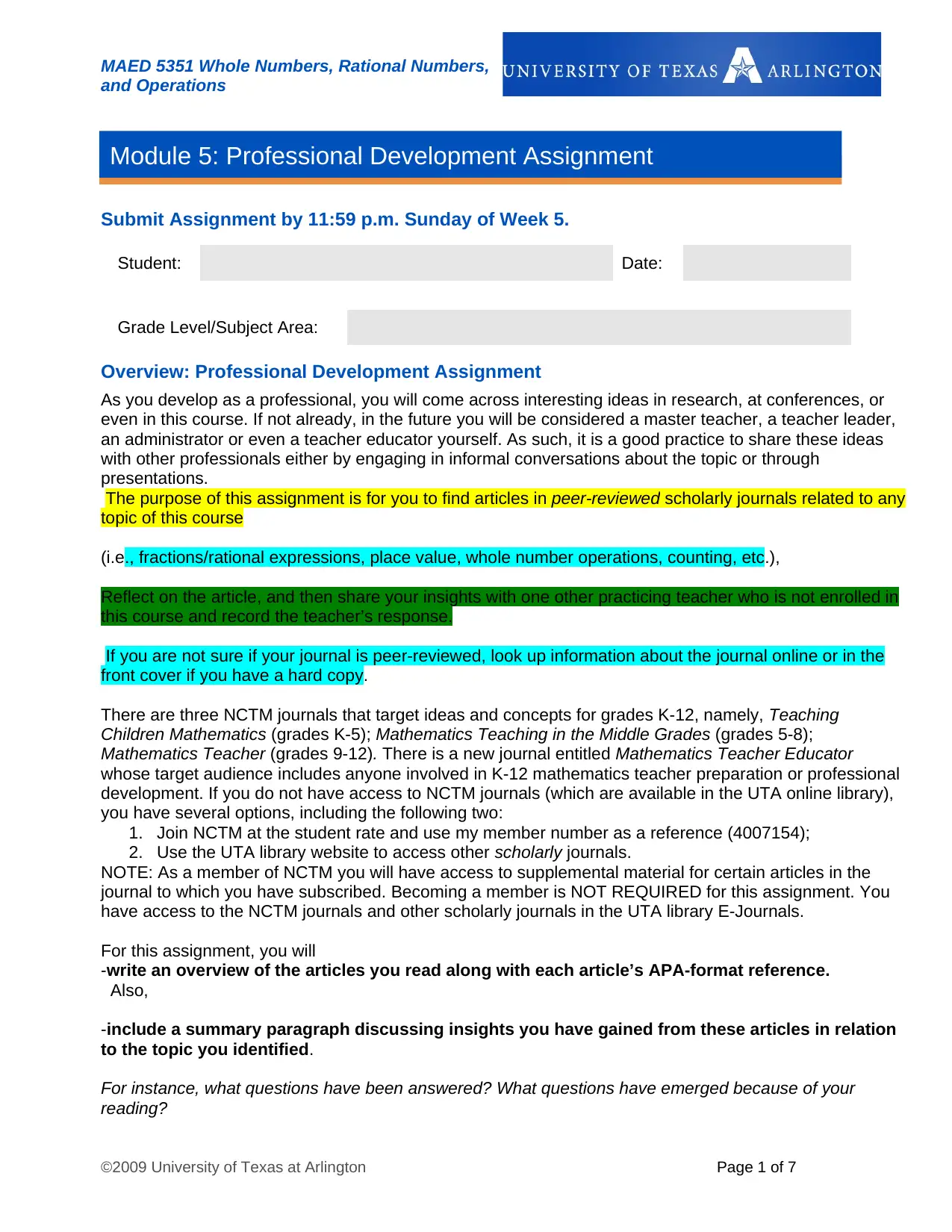
MAED 5351 Whole Numbers, Rational Numbers,
and Operations
Submit Assignment by 11:59 p.m. Sunday of Week 5.
Student: Date:
Grade Level/Subject Area:
Overview: Professional Development Assignment
As you develop as a professional, you will come across interesting ideas in research, at conferences, or
even in this course. If not already, in the future you will be considered a master teacher, a teacher leader,
an administrator or even a teacher educator yourself. As such, it is a good practice to share these ideas
with other professionals either by engaging in informal conversations about the topic or through
presentations.
The purpose of this assignment is for you to find articles in peer-reviewed scholarly journals related to any
topic of this course
(i.e., fractions/rational expressions, place value, whole number operations, counting, etc.),
Reflect on the article, and then share your insights with one other practicing teacher who is not enrolled in
this course and record the teacher’s response.
If you are not sure if your journal is peer-reviewed, look up information about the journal online or in the
front cover if you have a hard copy.
There are three NCTM journals that target ideas and concepts for grades K-12, namely, Teaching
Children Mathematics (grades K-5); Mathematics Teaching in the Middle Grades (grades 5-8);
Mathematics Teacher (grades 9-12). There is a new journal entitled Mathematics Teacher Educator
whose target audience includes anyone involved in K-12 mathematics teacher preparation or professional
development. If you do not have access to NCTM journals (which are available in the UTA online library),
you have several options, including the following two:
1. Join NCTM at the student rate and use my member number as a reference (4007154);
2. Use the UTA library website to access other scholarly journals.
NOTE: As a member of NCTM you will have access to supplemental material for certain articles in the
journal to which you have subscribed. Becoming a member is NOT REQUIRED for this assignment. You
have access to the NCTM journals and other scholarly journals in the UTA library E-Journals.
For this assignment, you will
-write an overview of the articles you read along with each article’s APA-format reference.
Also,
-include a summary paragraph discussing insights you have gained from these articles in relation
to the topic you identified.
For instance, what questions have been answered? What questions have emerged because of your
reading?
©2009 University of Texas at Arlington Page 1 of 7
Module 5: Professional Development Assignment
and Operations
Submit Assignment by 11:59 p.m. Sunday of Week 5.
Student: Date:
Grade Level/Subject Area:
Overview: Professional Development Assignment
As you develop as a professional, you will come across interesting ideas in research, at conferences, or
even in this course. If not already, in the future you will be considered a master teacher, a teacher leader,
an administrator or even a teacher educator yourself. As such, it is a good practice to share these ideas
with other professionals either by engaging in informal conversations about the topic or through
presentations.
The purpose of this assignment is for you to find articles in peer-reviewed scholarly journals related to any
topic of this course
(i.e., fractions/rational expressions, place value, whole number operations, counting, etc.),
Reflect on the article, and then share your insights with one other practicing teacher who is not enrolled in
this course and record the teacher’s response.
If you are not sure if your journal is peer-reviewed, look up information about the journal online or in the
front cover if you have a hard copy.
There are three NCTM journals that target ideas and concepts for grades K-12, namely, Teaching
Children Mathematics (grades K-5); Mathematics Teaching in the Middle Grades (grades 5-8);
Mathematics Teacher (grades 9-12). There is a new journal entitled Mathematics Teacher Educator
whose target audience includes anyone involved in K-12 mathematics teacher preparation or professional
development. If you do not have access to NCTM journals (which are available in the UTA online library),
you have several options, including the following two:
1. Join NCTM at the student rate and use my member number as a reference (4007154);
2. Use the UTA library website to access other scholarly journals.
NOTE: As a member of NCTM you will have access to supplemental material for certain articles in the
journal to which you have subscribed. Becoming a member is NOT REQUIRED for this assignment. You
have access to the NCTM journals and other scholarly journals in the UTA library E-Journals.
For this assignment, you will
-write an overview of the articles you read along with each article’s APA-format reference.
Also,
-include a summary paragraph discussing insights you have gained from these articles in relation
to the topic you identified.
For instance, what questions have been answered? What questions have emerged because of your
reading?
©2009 University of Texas at Arlington Page 1 of 7
Module 5: Professional Development Assignment
Paraphrase This Document
Need a fresh take? Get an instant paraphrase of this document with our AI Paraphraser
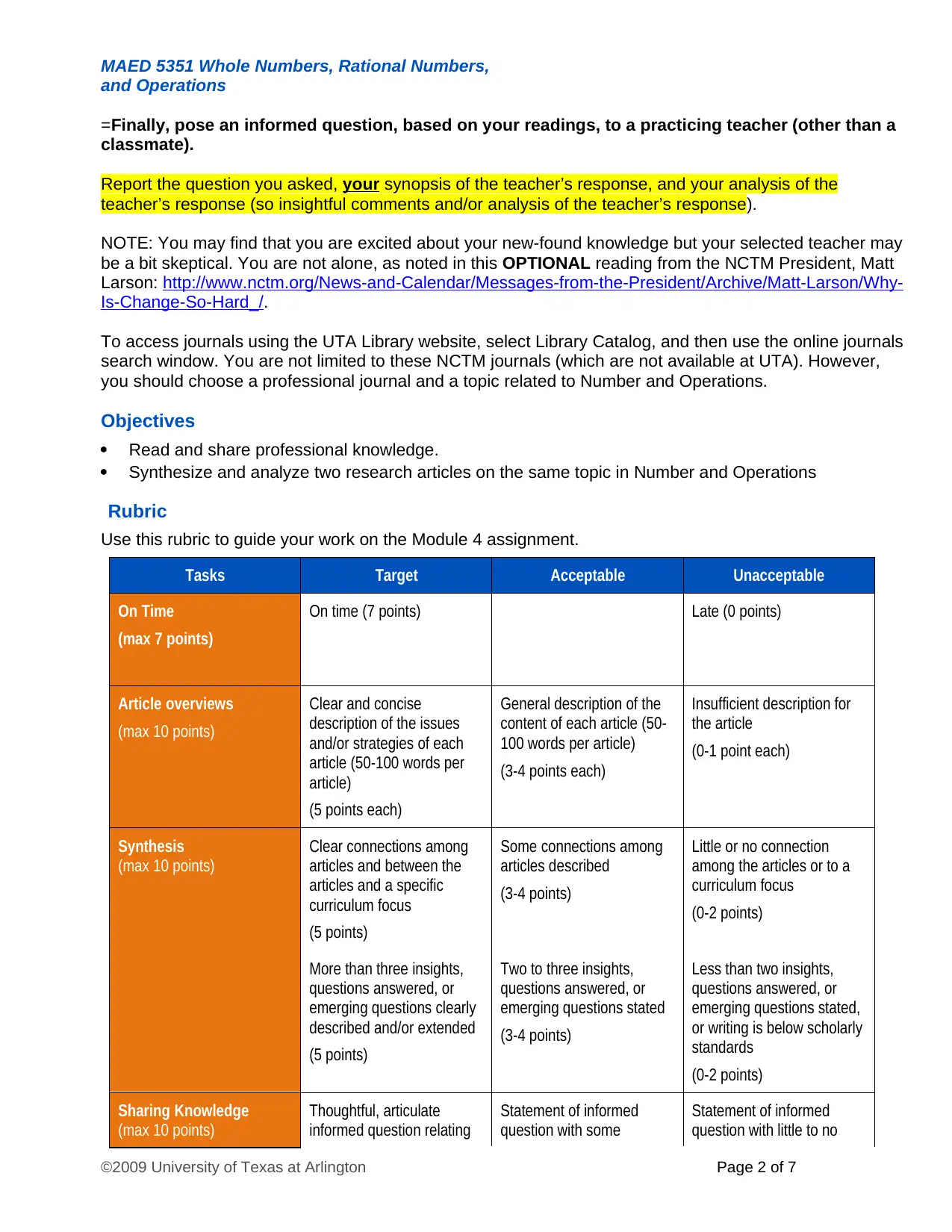
MAED 5351 Whole Numbers, Rational Numbers,
and Operations
=Finally, pose an informed question, based on your readings, to a practicing teacher (other than a
classmate).
Report the question you asked, your synopsis of the teacher’s response, and your analysis of the
teacher’s response (so insightful comments and/or analysis of the teacher’s response).
NOTE: You may find that you are excited about your new-found knowledge but your selected teacher may
be a bit skeptical. You are not alone, as noted in this OPTIONAL reading from the NCTM President, Matt
Larson: http://www.nctm.org/News-and-Calendar/Messages-from-the-President/Archive/Matt-Larson/Why-
Is-Change-So-Hard_/.
To access journals using the UTA Library website, select Library Catalog, and then use the online journals
search window. You are not limited to these NCTM journals (which are not available at UTA). However,
you should choose a professional journal and a topic related to Number and Operations.
Objectives
Read and share professional knowledge.
Synthesize and analyze two research articles on the same topic in Number and Operations
Rubric
Use this rubric to guide your work on the Module 4 assignment.
Tasks Target Acceptable Unacceptable
On Time
(max 7 points)
On time (7 points) Late (0 points)
Article overviews
(max 10 points)
Clear and concise
description of the issues
and/or strategies of each
article (50-100 words per
article)
(5 points each)
General description of the
content of each article (50-
100 words per article)
(3-4 points each)
Insufficient description for
the article
(0-1 point each)
Synthesis
(max 10 points)
Clear connections among
articles and between the
articles and a specific
curriculum focus
(5 points)
Some connections among
articles described
(3-4 points)
Little or no connection
among the articles or to a
curriculum focus
(0-2 points)
More than three insights,
questions answered, or
emerging questions clearly
described and/or extended
(5 points)
Two to three insights,
questions answered, or
emerging questions stated
(3-4 points)
Less than two insights,
questions answered, or
emerging questions stated,
or writing is below scholarly
standards
(0-2 points)
Sharing Knowledge
(max 10 points)
Thoughtful, articulate
informed question relating
Statement of informed
question with some
Statement of informed
question with little to no
©2009 University of Texas at Arlington Page 2 of 7
and Operations
=Finally, pose an informed question, based on your readings, to a practicing teacher (other than a
classmate).
Report the question you asked, your synopsis of the teacher’s response, and your analysis of the
teacher’s response (so insightful comments and/or analysis of the teacher’s response).
NOTE: You may find that you are excited about your new-found knowledge but your selected teacher may
be a bit skeptical. You are not alone, as noted in this OPTIONAL reading from the NCTM President, Matt
Larson: http://www.nctm.org/News-and-Calendar/Messages-from-the-President/Archive/Matt-Larson/Why-
Is-Change-So-Hard_/.
To access journals using the UTA Library website, select Library Catalog, and then use the online journals
search window. You are not limited to these NCTM journals (which are not available at UTA). However,
you should choose a professional journal and a topic related to Number and Operations.
Objectives
Read and share professional knowledge.
Synthesize and analyze two research articles on the same topic in Number and Operations
Rubric
Use this rubric to guide your work on the Module 4 assignment.
Tasks Target Acceptable Unacceptable
On Time
(max 7 points)
On time (7 points) Late (0 points)
Article overviews
(max 10 points)
Clear and concise
description of the issues
and/or strategies of each
article (50-100 words per
article)
(5 points each)
General description of the
content of each article (50-
100 words per article)
(3-4 points each)
Insufficient description for
the article
(0-1 point each)
Synthesis
(max 10 points)
Clear connections among
articles and between the
articles and a specific
curriculum focus
(5 points)
Some connections among
articles described
(3-4 points)
Little or no connection
among the articles or to a
curriculum focus
(0-2 points)
More than three insights,
questions answered, or
emerging questions clearly
described and/or extended
(5 points)
Two to three insights,
questions answered, or
emerging questions stated
(3-4 points)
Less than two insights,
questions answered, or
emerging questions stated,
or writing is below scholarly
standards
(0-2 points)
Sharing Knowledge
(max 10 points)
Thoughtful, articulate
informed question relating
Statement of informed
question with some
Statement of informed
question with little to no
©2009 University of Texas at Arlington Page 2 of 7
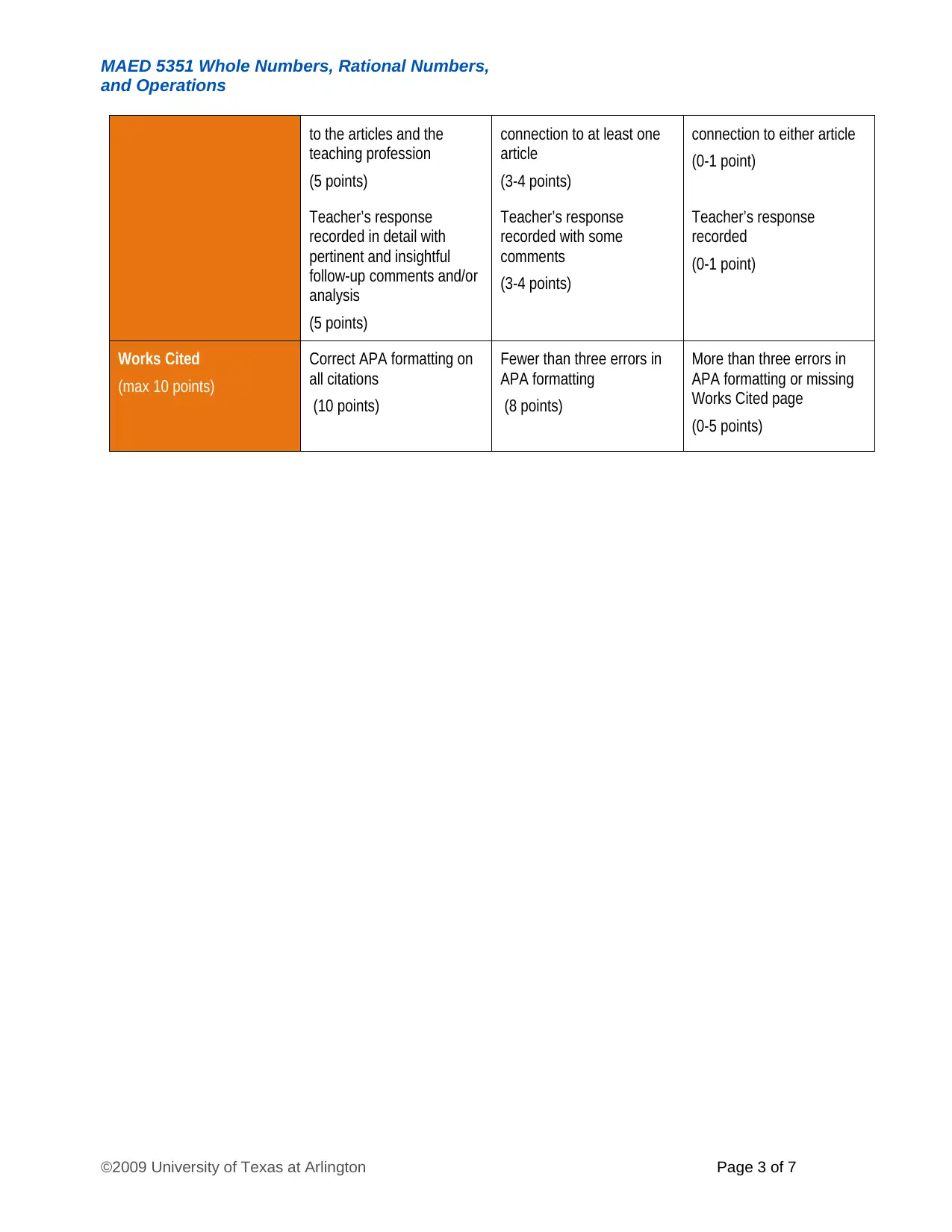
MAED 5351 Whole Numbers, Rational Numbers,
and Operations
to the articles and the
teaching profession
(5 points)
connection to at least one
article
(3-4 points)
connection to either article
(0-1 point)
Teacher’s response
recorded in detail with
pertinent and insightful
follow-up comments and/or
analysis
(5 points)
Teacher’s response
recorded with some
comments
(3-4 points)
Teacher’s response
recorded
(0-1 point)
Works Cited
(max 10 points)
Correct APA formatting on
all citations
(10 points)
Fewer than three errors in
APA formatting
(8 points)
More than three errors in
APA formatting or missing
Works Cited page
(0-5 points)
©2009 University of Texas at Arlington Page 3 of 7
and Operations
to the articles and the
teaching profession
(5 points)
connection to at least one
article
(3-4 points)
connection to either article
(0-1 point)
Teacher’s response
recorded in detail with
pertinent and insightful
follow-up comments and/or
analysis
(5 points)
Teacher’s response
recorded with some
comments
(3-4 points)
Teacher’s response
recorded
(0-1 point)
Works Cited
(max 10 points)
Correct APA formatting on
all citations
(10 points)
Fewer than three errors in
APA formatting
(8 points)
More than three errors in
APA formatting or missing
Works Cited page
(0-5 points)
©2009 University of Texas at Arlington Page 3 of 7
⊘ This is a preview!⊘
Do you want full access?
Subscribe today to unlock all pages.

Trusted by 1+ million students worldwide
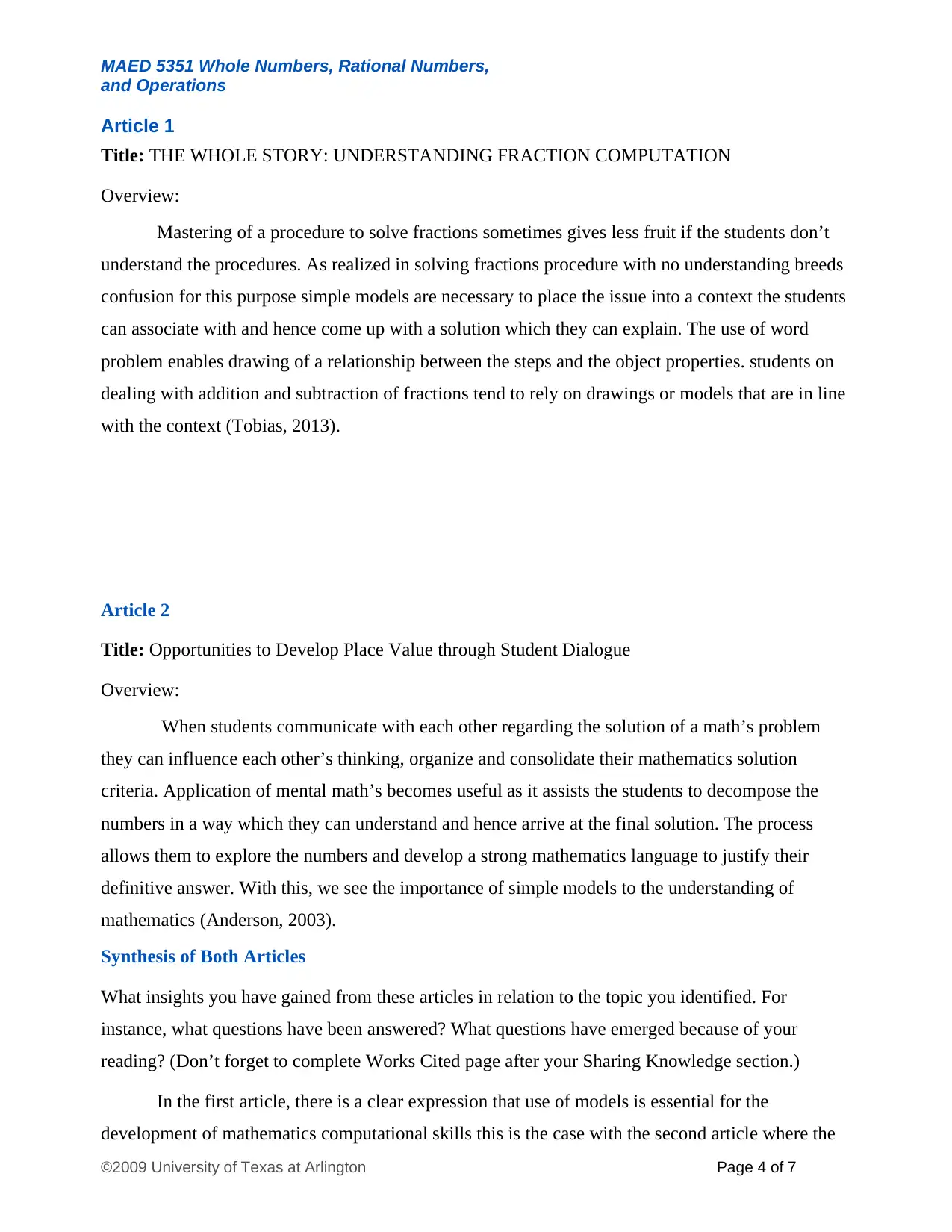
MAED 5351 Whole Numbers, Rational Numbers,
and Operations
Article 1
Title: THE WHOLE STORY: UNDERSTANDING FRACTION COMPUTATION
Overview:
Mastering of a procedure to solve fractions sometimes gives less fruit if the students don’t
understand the procedures. As realized in solving fractions procedure with no understanding breeds
confusion for this purpose simple models are necessary to place the issue into a context the students
can associate with and hence come up with a solution which they can explain. The use of word
problem enables drawing of a relationship between the steps and the object properties. students on
dealing with addition and subtraction of fractions tend to rely on drawings or models that are in line
with the context (Tobias, 2013).
Article 2
Title: Opportunities to Develop Place Value through Student Dialogue
Overview:
When students communicate with each other regarding the solution of a math’s problem
they can influence each other’s thinking, organize and consolidate their mathematics solution
criteria. Application of mental math’s becomes useful as it assists the students to decompose the
numbers in a way which they can understand and hence arrive at the final solution. The process
allows them to explore the numbers and develop a strong mathematics language to justify their
definitive answer. With this, we see the importance of simple models to the understanding of
mathematics (Anderson, 2003).
Synthesis of Both Articles
What insights you have gained from these articles in relation to the topic you identified. For
instance, what questions have been answered? What questions have emerged because of your
reading? (Don’t forget to complete Works Cited page after your Sharing Knowledge section.)
In the first article, there is a clear expression that use of models is essential for the
development of mathematics computational skills this is the case with the second article where the
©2009 University of Texas at Arlington Page 4 of 7
and Operations
Article 1
Title: THE WHOLE STORY: UNDERSTANDING FRACTION COMPUTATION
Overview:
Mastering of a procedure to solve fractions sometimes gives less fruit if the students don’t
understand the procedures. As realized in solving fractions procedure with no understanding breeds
confusion for this purpose simple models are necessary to place the issue into a context the students
can associate with and hence come up with a solution which they can explain. The use of word
problem enables drawing of a relationship between the steps and the object properties. students on
dealing with addition and subtraction of fractions tend to rely on drawings or models that are in line
with the context (Tobias, 2013).
Article 2
Title: Opportunities to Develop Place Value through Student Dialogue
Overview:
When students communicate with each other regarding the solution of a math’s problem
they can influence each other’s thinking, organize and consolidate their mathematics solution
criteria. Application of mental math’s becomes useful as it assists the students to decompose the
numbers in a way which they can understand and hence arrive at the final solution. The process
allows them to explore the numbers and develop a strong mathematics language to justify their
definitive answer. With this, we see the importance of simple models to the understanding of
mathematics (Anderson, 2003).
Synthesis of Both Articles
What insights you have gained from these articles in relation to the topic you identified. For
instance, what questions have been answered? What questions have emerged because of your
reading? (Don’t forget to complete Works Cited page after your Sharing Knowledge section.)
In the first article, there is a clear expression that use of models is essential for the
development of mathematics computational skills this is the case with the second article where the
©2009 University of Texas at Arlington Page 4 of 7
Paraphrase This Document
Need a fresh take? Get an instant paraphrase of this document with our AI Paraphraser
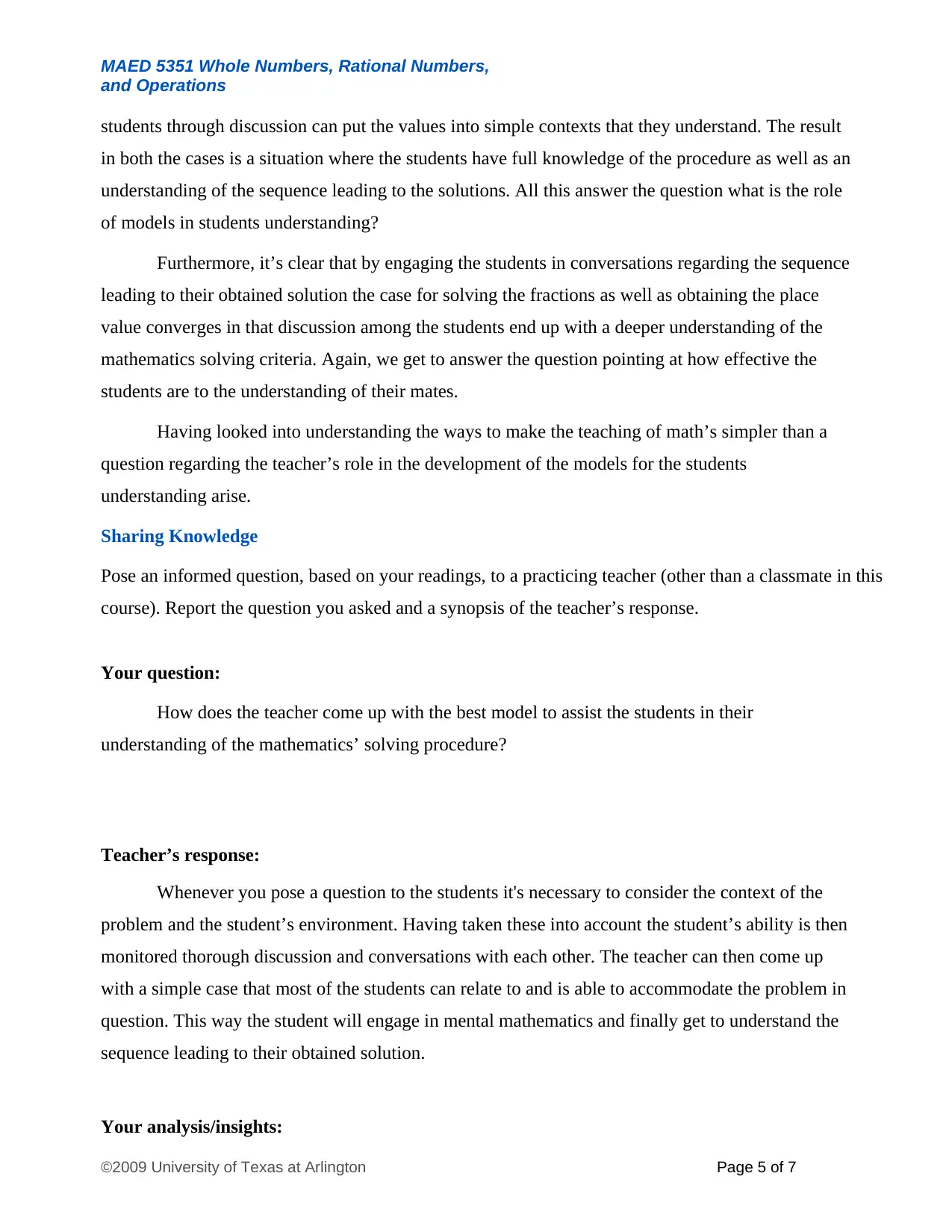
MAED 5351 Whole Numbers, Rational Numbers,
and Operations
students through discussion can put the values into simple contexts that they understand. The result
in both the cases is a situation where the students have full knowledge of the procedure as well as an
understanding of the sequence leading to the solutions. All this answer the question what is the role
of models in students understanding?
Furthermore, it’s clear that by engaging the students in conversations regarding the sequence
leading to their obtained solution the case for solving the fractions as well as obtaining the place
value converges in that discussion among the students end up with a deeper understanding of the
mathematics solving criteria. Again, we get to answer the question pointing at how effective the
students are to the understanding of their mates.
Having looked into understanding the ways to make the teaching of math’s simpler than a
question regarding the teacher’s role in the development of the models for the students
understanding arise.
Sharing Knowledge
Pose an informed question, based on your readings, to a practicing teacher (other than a classmate in this
course). Report the question you asked and a synopsis of the teacher’s response.
Your question:
How does the teacher come up with the best model to assist the students in their
understanding of the mathematics’ solving procedure?
Teacher’s response:
Whenever you pose a question to the students it's necessary to consider the context of the
problem and the student’s environment. Having taken these into account the student’s ability is then
monitored thorough discussion and conversations with each other. The teacher can then come up
with a simple case that most of the students can relate to and is able to accommodate the problem in
question. This way the student will engage in mental mathematics and finally get to understand the
sequence leading to their obtained solution.
Your analysis/insights:
©2009 University of Texas at Arlington Page 5 of 7
and Operations
students through discussion can put the values into simple contexts that they understand. The result
in both the cases is a situation where the students have full knowledge of the procedure as well as an
understanding of the sequence leading to the solutions. All this answer the question what is the role
of models in students understanding?
Furthermore, it’s clear that by engaging the students in conversations regarding the sequence
leading to their obtained solution the case for solving the fractions as well as obtaining the place
value converges in that discussion among the students end up with a deeper understanding of the
mathematics solving criteria. Again, we get to answer the question pointing at how effective the
students are to the understanding of their mates.
Having looked into understanding the ways to make the teaching of math’s simpler than a
question regarding the teacher’s role in the development of the models for the students
understanding arise.
Sharing Knowledge
Pose an informed question, based on your readings, to a practicing teacher (other than a classmate in this
course). Report the question you asked and a synopsis of the teacher’s response.
Your question:
How does the teacher come up with the best model to assist the students in their
understanding of the mathematics’ solving procedure?
Teacher’s response:
Whenever you pose a question to the students it's necessary to consider the context of the
problem and the student’s environment. Having taken these into account the student’s ability is then
monitored thorough discussion and conversations with each other. The teacher can then come up
with a simple case that most of the students can relate to and is able to accommodate the problem in
question. This way the student will engage in mental mathematics and finally get to understand the
sequence leading to their obtained solution.
Your analysis/insights:
©2009 University of Texas at Arlington Page 5 of 7
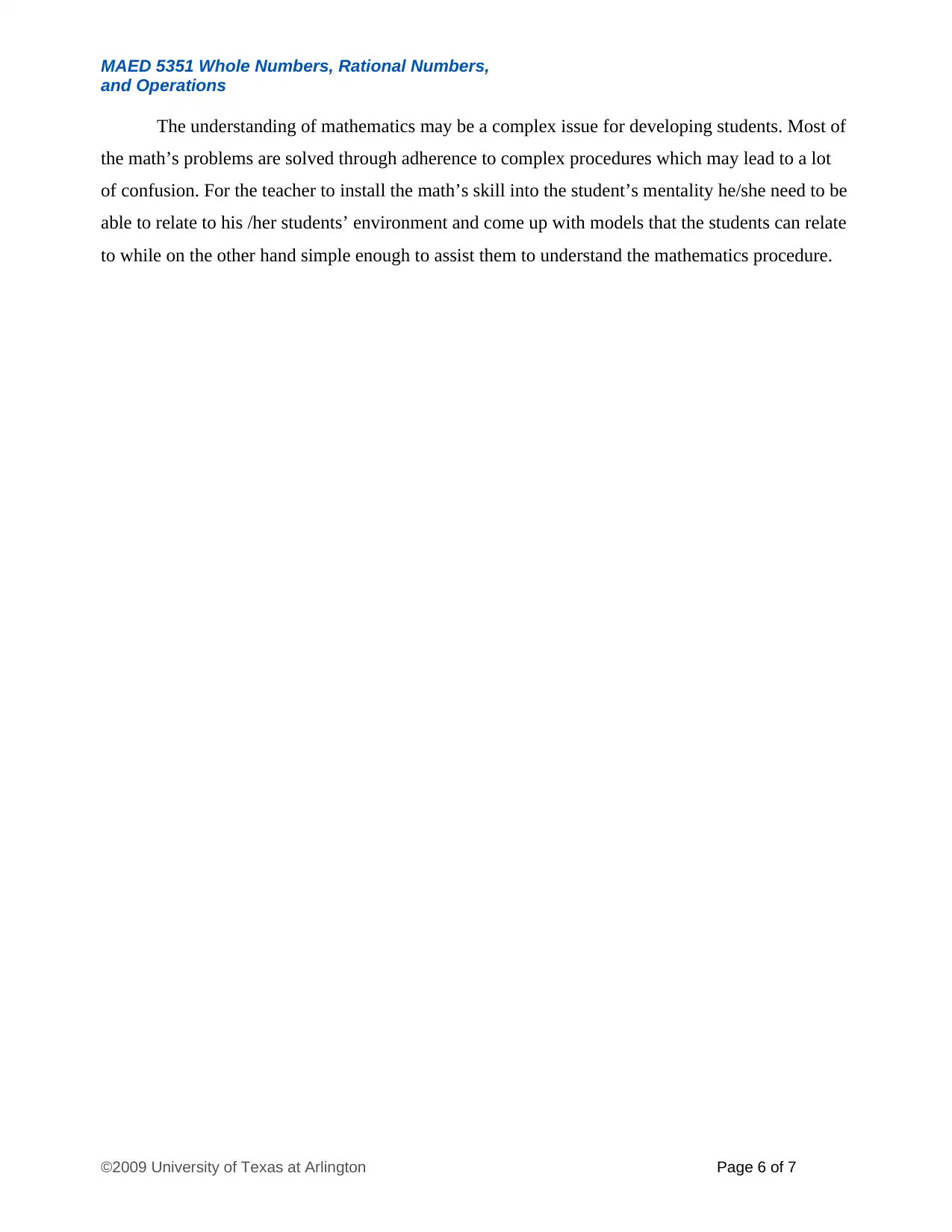
MAED 5351 Whole Numbers, Rational Numbers,
and Operations
The understanding of mathematics may be a complex issue for developing students. Most of
the math’s problems are solved through adherence to complex procedures which may lead to a lot
of confusion. For the teacher to install the math’s skill into the student’s mentality he/she need to be
able to relate to his /her students’ environment and come up with models that the students can relate
to while on the other hand simple enough to assist them to understand the mathematics procedure.
©2009 University of Texas at Arlington Page 6 of 7
and Operations
The understanding of mathematics may be a complex issue for developing students. Most of
the math’s problems are solved through adherence to complex procedures which may lead to a lot
of confusion. For the teacher to install the math’s skill into the student’s mentality he/she need to be
able to relate to his /her students’ environment and come up with models that the students can relate
to while on the other hand simple enough to assist them to understand the mathematics procedure.
©2009 University of Texas at Arlington Page 6 of 7
⊘ This is a preview!⊘
Do you want full access?
Subscribe today to unlock all pages.

Trusted by 1+ million students worldwide
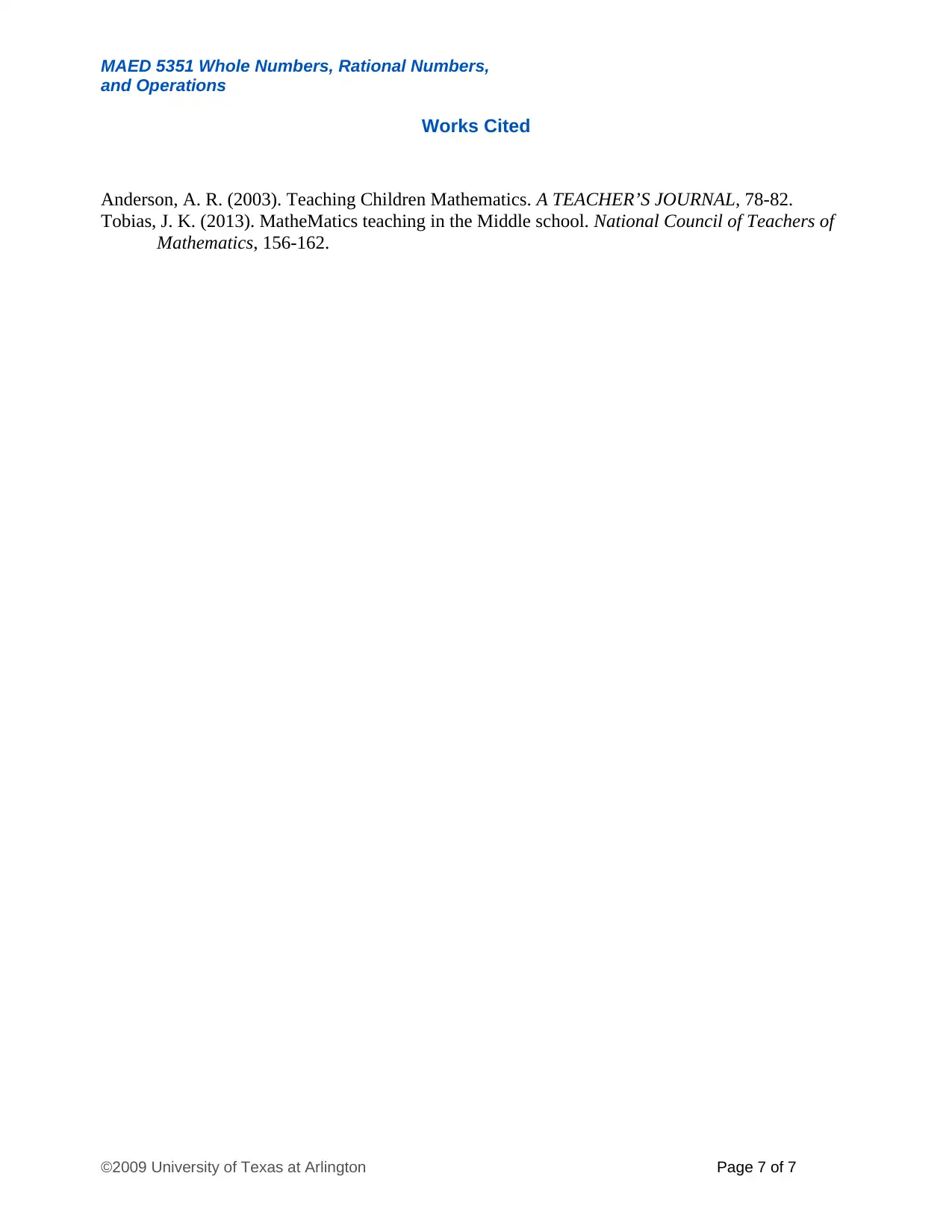
MAED 5351 Whole Numbers, Rational Numbers,
and Operations
Works Cited
Anderson, A. R. (2003). Teaching Children Mathematics. A TEACHER’S JOURNAL, 78-82.
Tobias, J. K. (2013). MatheMatics teaching in the Middle school. National Council of Teachers of
Mathematics, 156-162.
©2009 University of Texas at Arlington Page 7 of 7
and Operations
Works Cited
Anderson, A. R. (2003). Teaching Children Mathematics. A TEACHER’S JOURNAL, 78-82.
Tobias, J. K. (2013). MatheMatics teaching in the Middle school. National Council of Teachers of
Mathematics, 156-162.
©2009 University of Texas at Arlington Page 7 of 7
1 out of 7
Related Documents
Your All-in-One AI-Powered Toolkit for Academic Success.
+13062052269
info@desklib.com
Available 24*7 on WhatsApp / Email
![[object Object]](/_next/static/media/star-bottom.7253800d.svg)
Unlock your academic potential
Copyright © 2020–2025 A2Z Services. All Rights Reserved. Developed and managed by ZUCOL.





